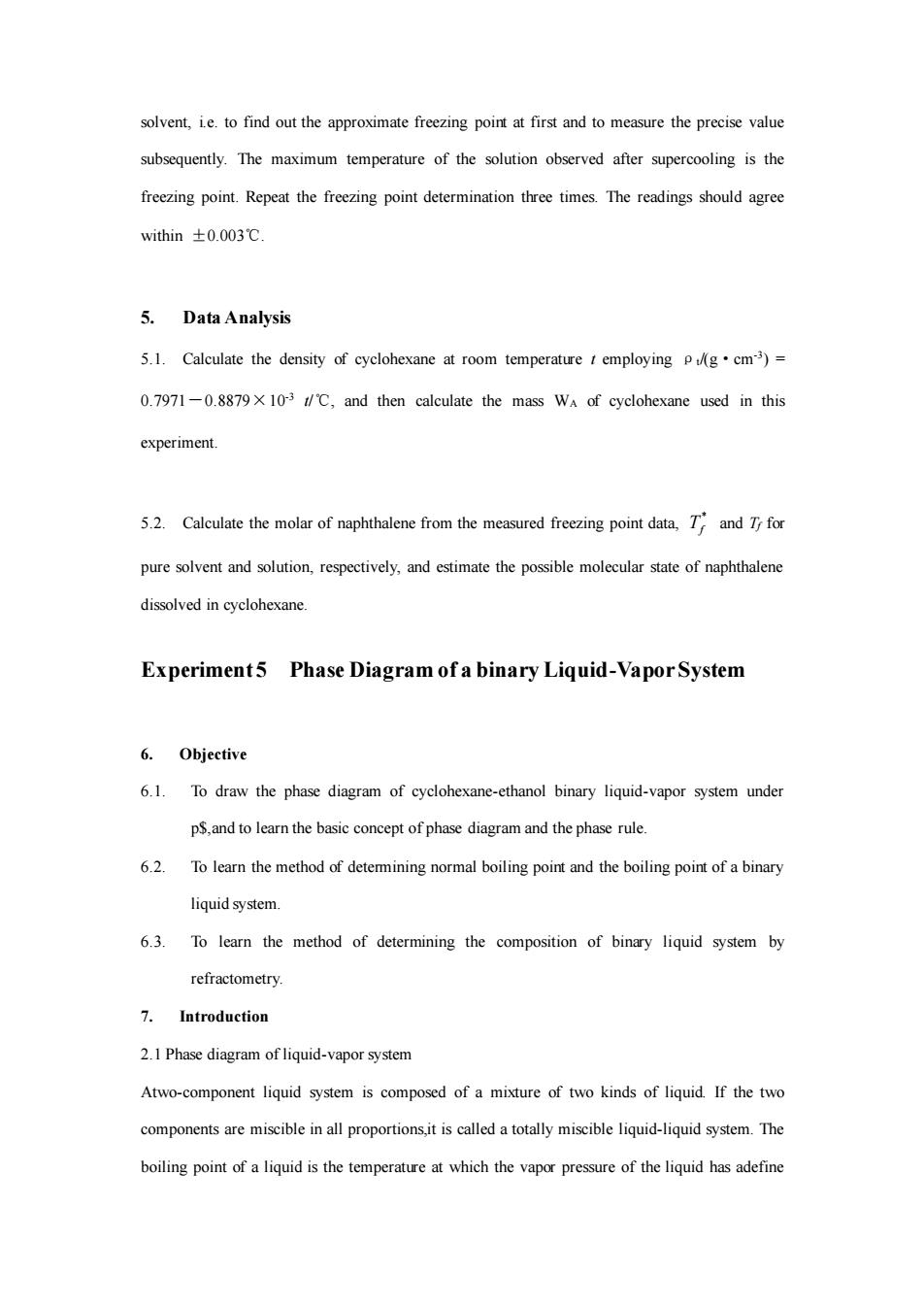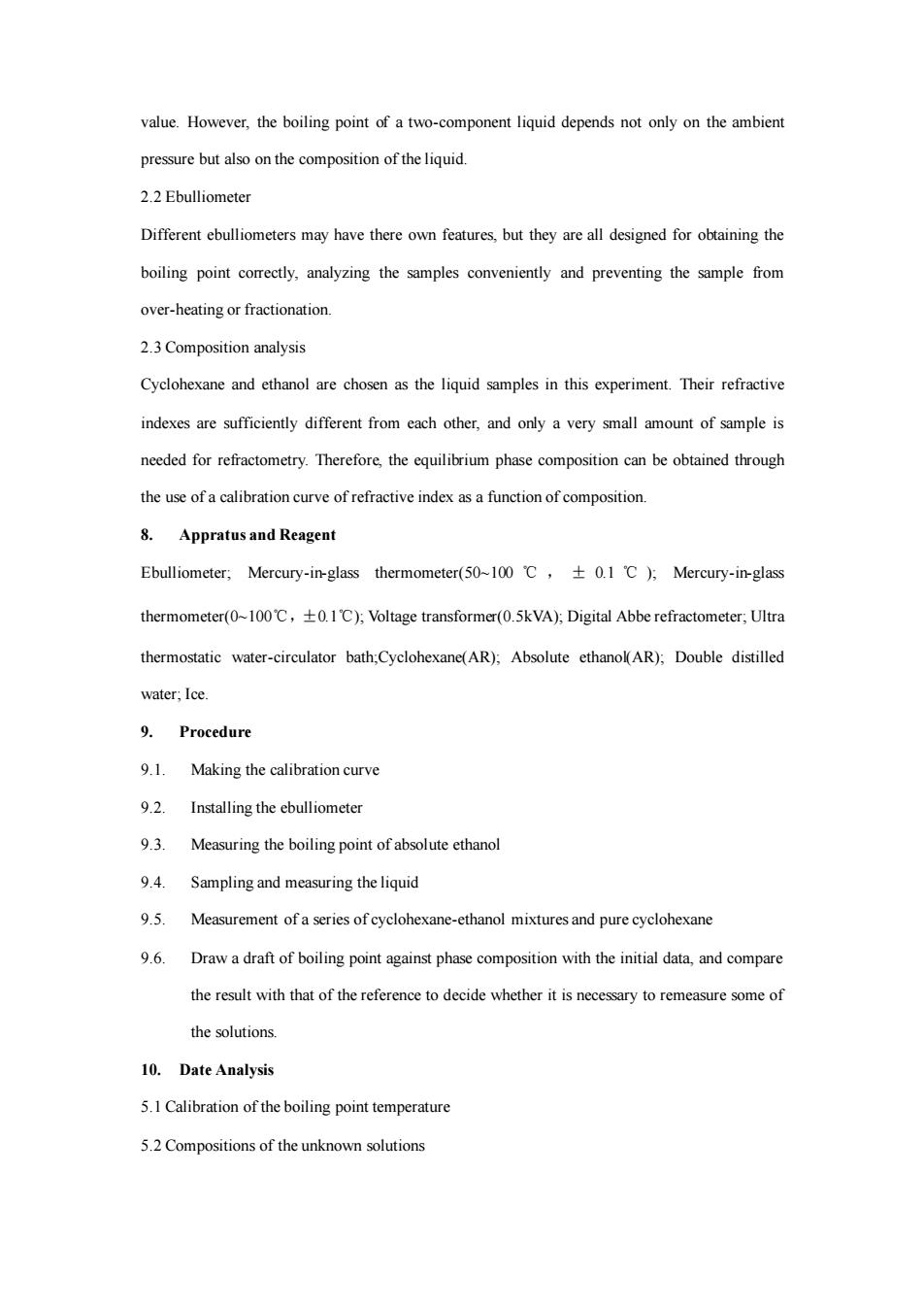
solvent,ie.to find out the approximate freezing point at first and to measure the precise value subsequently.The maximum temperature of the solution observed after supercooling is the freezing point.Repeat the freezing point determination three times.The readings should agree within±0.003℃. 5.Data Analysis 5.1.Calculate the density of cyclohexane at room temperature)= 0.7971-0.8879x103/C,and then calculate the mass W of cyclohexane used in this experiment. 5.2.Calculate the molar of naphthalene from the measured freezing point data,T and Tfor pure solvent and solution,respectively,and estimate the possible molecular state of naphthalene dissolved in cyclohexane Experiment5 Phase Diagram of a binary Liquid-VaporSystem 6.Objective 6.1.To draw the phase diagram of cyclohexane-ethanol binary liquid-vapor system under ps.and to learn the basic concept of phase diagram and the phase rule 6.2.To learn the method of determining normal boiling point and the boiling point of a binary liquidsystem 6.3.To learn the method of determining the composition of binary liquid system by refractometry 7.Introduction 2.1 Phase diagram of liquid-vapor system Atwo-component liquid system is composed of a mixture of two kinds of liquid If the two components are miscible inall proportionsit is called a totally miscible liquid-iqud system.The boiling point of a liquid is the temperature at which the vapor pressure of the liquid has adefine
solvent, i.e. to find out the approximate freezing point at first and to measure the precise value subsequently. The maximum temperature of the solution observed after supercooling is the freezing point. Repeat the freezing point determination three times. The readings should agree within ±0.003℃. 5. Data Analysis 5.1. Calculate the density of cyclohexane at room temperature t employing ρt/(g·cm-3 ) = 0.7971-0.8879×10-3 t/℃, and then calculate the mass WA of cyclohexane used in this experiment. 5.2. Calculate the molar of naphthalene from the measured freezing point data, * Tf and Tf for pure solvent and solution, respectively, and estimate the possible molecular state of naphthalene dissolved in cyclohexane. Experiment 5 Phase Diagram of a binary Liquid-Vapor System 6. Objective 6.1. To draw the phase diagram of cyclohexane-ethanol binary liquid-vapor system under p$,and to learn the basic concept of phase diagram and the phase rule. 6.2. To learn the method of determining normal boiling point and the boiling point of a binary liquid system. 6.3. To learn the method of determining the composition of binary liquid system by refractometry. 7. Introduction 2.1 Phase diagram of liquid-vapor system Atwo-component liquid system is composed of a mixture of two kinds of liquid. If the two components are miscible in all proportions,it is called a totally miscible liquid-liquid system. The boiling point of a liquid is the temperature at which the vapor pressure of the liquid has adefine

value.However,the boiling point of a two-component liquid depends not only on the ambient pressure but also on the composition of the liquid. 22Ebulliometer Different ebulliometers may have there own features,but they are all designed for obtaining the boiling point comrectly,analyzing the samples conveniently and preventing the sample from over-heating or fractionation. 2.3Composition analysis Cyclohexane and ethanol are chosen as the liquid samples in this experiment.Their refractive indexes are sufficiently different from each other,and only a very small amount of sample is needed for refractometry.Therefore phase composition can be obtained the use of a calibration curve of refractive index as a function of composition. 8.Appratus and Reagent Ebulliometer,.Mercury-in-glass thermometer(50-100℃,±0.1℃)方Mercury-lass thermometer(C):Voltage transformer(0.5kVA):Digital Abbe refractometer,Ultra thermostatic water-circulator bath;Cyclohexane(AR):Absolute ethanoK(AR):Double distilled water.Ice. 9.Procedure 9.1.Making the calibration curve 9.2.Installing the ebulliometer 9.3.Measuring the boiling point of absolute ethanol 9.4 Sampling and measuring the liquid 9.5. Measurement of a series of cyclohexane-ethanol mixtures and pure cyclohexane 9.6.Draw a draft of boiling point against phase composition with the initial data,and compare the result with that of the reference to decide whether it is necessary to remeasure some of the solutions. 10.Date Analysis 5.1Calibration of the boiling point temperature 5.2 Compositions of the unknown solutions
value. However, the boiling point of a two-component liquid depends not only on the ambient pressure but also on the composition of the liquid. 2.2 Ebulliometer Different ebulliometers may have there own features, but they are all designed for obtaining the boiling point correctly, analyzing the samples conveniently and preventing the sample from over-heating or fractionation. 2.3 Composition analysis Cyclohexane and ethanol are chosen as the liquid samples in this experiment. Their refractive indexes are sufficiently different from each other, and only a very small amount of sample is needed for refractometry. Therefore, the equilibrium phase composition can be obtained through the use of a calibration curve of refractive index as a function of composition. 8. Appratus and Reagent Ebulliometer; Mercury-in-glass thermometer(50~100 ℃,± 0.1 ℃ ); Mercury-in-glass thermometer(0~100℃,±0.1℃); Voltage transformer(0.5kVA); Digital Abbe refractometer; Ultra thermostatic water-circulator bath;Cyclohexane(AR); Absolute ethanol(AR); Double distilled water; Ice. 9. Procedure 9.1. Making the calibration curve 9.2. Installing the ebulliometer 9.3. Measuring the boiling point of absolute ethanol 9.4. Sampling and measuring the liquid 9.5. Measurement of a series of cyclohexane-ethanol mixtures and pure cyclohexane 9.6. Draw a draft of boiling point against phase composition with the initial data, and compare the result with that of the reference to decide whether it is necessary to remeasure some of the solutions. 10. Date Analysis 5.1 Calibration of the boiling point temperature 5.2 Compositions of the unknown solutions